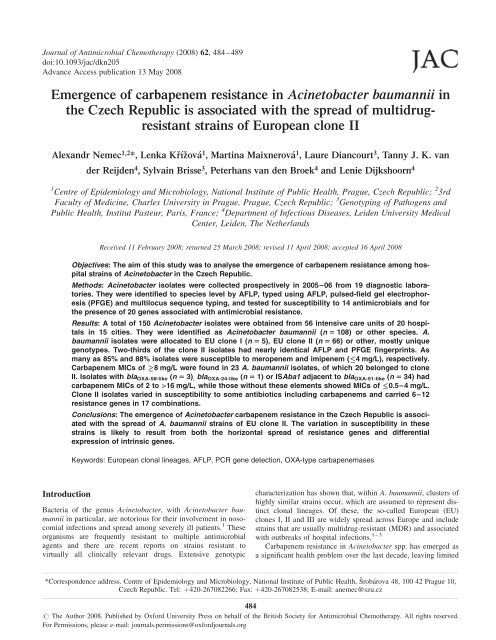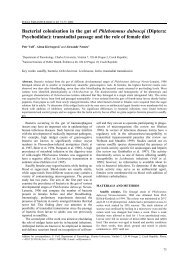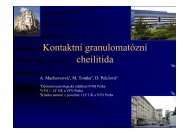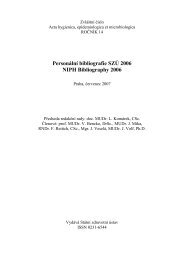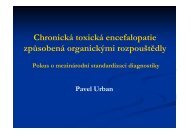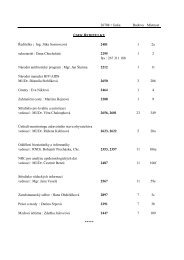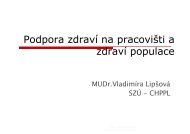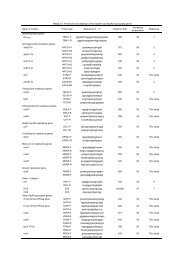Emergence of carbapenem resistance in Acinetobacter baumannii ...
Emergence of carbapenem resistance in Acinetobacter baumannii ...
Emergence of carbapenem resistance in Acinetobacter baumannii ...
You also want an ePaper? Increase the reach of your titles
YUMPU automatically turns print PDFs into web optimized ePapers that Google loves.
Journal <strong>of</strong> Antimicrobial Chemotherapy (2008) 62, 484–489<br />
doi:10.1093/jac/dkn205<br />
Advance Access publication 13 May 2008<br />
<strong>Emergence</strong> <strong>of</strong> <strong>carbapenem</strong> <strong>resistance</strong> <strong>in</strong> Ac<strong>in</strong>etobacter <strong>baumannii</strong> <strong>in</strong><br />
the Czech Republic is associated with the spread <strong>of</strong> multidrugresistant<br />
stra<strong>in</strong>s <strong>of</strong> European clone II<br />
Alexandr Nemec 1,2 *, Lenka Křížová 1 , Mart<strong>in</strong>a Maixnerová 1 , Laure Diancourt 3 , Tanny J. K. van<br />
der Reijden 4 , Sylva<strong>in</strong> Brisse 3 , Peterhans van den Broek 4 and Lenie Dijkshoorn 4<br />
1 Centre <strong>of</strong> Epidemiology and Microbiology, National Institute <strong>of</strong> Public Health, Prague, Czech Republic; 2 3rd<br />
Faculty <strong>of</strong> Medic<strong>in</strong>e, Charles University <strong>in</strong> Prague, Prague, Czech Republic; 3 Genotyp<strong>in</strong>g <strong>of</strong> Pathogens and<br />
Public Health, Institut Pasteur, Paris, France; 4 Department <strong>of</strong> Infectious Diseases, Leiden University Medical<br />
Center, Leiden, The Netherlands<br />
Received 11 February 2008; returned 25 March 2008; revised 11 April 2008; accepted 16 April 2008<br />
Objectives: The aim <strong>of</strong> this study was to analyse the emergence <strong>of</strong> <strong>carbapenem</strong> <strong>resistance</strong> among hospital<br />
stra<strong>in</strong>s <strong>of</strong> Ac<strong>in</strong>etobacter <strong>in</strong> the Czech Republic.<br />
Methods: Ac<strong>in</strong>etobacter isolates were collected prospectively <strong>in</strong> 2005–06 from 19 diagnostic laboratories.<br />
They were identified to species level by AFLP, typed us<strong>in</strong>g AFLP, pulsed-field gel electrophoresis<br />
(PFGE) and multilocus sequence typ<strong>in</strong>g, and tested for susceptibility to 14 antimicrobials and for<br />
the presence <strong>of</strong> 20 genes associated with antimicrobial <strong>resistance</strong>.<br />
Results: A total <strong>of</strong> 150 Ac<strong>in</strong>etobacter isolates were obta<strong>in</strong>ed from 56 <strong>in</strong>tensive care units <strong>of</strong> 20 hospitals<br />
<strong>in</strong> 15 cities. They were identified as Ac<strong>in</strong>etobacter <strong>baumannii</strong> (n 5 108) or other species. A.<br />
<strong>baumannii</strong> isolates were allocated to EU clone I (n 5 5), EU clone II (n 5 66) or other, mostly unique<br />
genotypes. Two-thirds <strong>of</strong> the clone II isolates had nearly identical AFLP and PFGE f<strong>in</strong>gerpr<strong>in</strong>ts. As<br />
many as 85% and 88% isolates were susceptible to meropenem and imipenem (4 mg/L), respectively.<br />
Carbapenem MICs <strong>of</strong> 8 mg/L were found <strong>in</strong> 23 A. <strong>baumannii</strong> isolates, <strong>of</strong> which 20 belonged to clone<br />
II. Isolates with bla OXA-58-like (n 5 3) , bla OXA-24-like (n 5 1) or ISAba1 adjacent to bla OXA-51-like (n 5 34) had<br />
<strong>carbapenem</strong> MICs <strong>of</strong> 2 to >16 mg/L, while those without these elements showed MICs <strong>of</strong> 0.5–4 mg/L.<br />
Clone II isolates varied <strong>in</strong> susceptibility to some antibiotics <strong>in</strong>clud<strong>in</strong>g <strong>carbapenem</strong>s and carried 6–12<br />
<strong>resistance</strong> genes <strong>in</strong> 17 comb<strong>in</strong>ations.<br />
Conclusions: The emergence <strong>of</strong> Ac<strong>in</strong>etobacter <strong>carbapenem</strong> <strong>resistance</strong> <strong>in</strong> the Czech Republic is associated<br />
with the spread <strong>of</strong> A. <strong>baumannii</strong> stra<strong>in</strong>s <strong>of</strong> EU clone II. The variation <strong>in</strong> susceptibility <strong>in</strong> these<br />
stra<strong>in</strong>s is likely to result from both the horizontal spread <strong>of</strong> <strong>resistance</strong> genes and differential<br />
expression <strong>of</strong> <strong>in</strong>tr<strong>in</strong>sic genes.<br />
Keywords: European clonal l<strong>in</strong>eages, AFLP, PCR gene detection, OXA-type <strong>carbapenem</strong>ases<br />
Introduction<br />
Bacteria <strong>of</strong> the genus Ac<strong>in</strong>etobacter, with Ac<strong>in</strong>etobacter <strong>baumannii</strong><br />
<strong>in</strong> particular, are notorious for their <strong>in</strong>volvement <strong>in</strong> nosocomial<br />
<strong>in</strong>fections and spread among severely ill patients. 1 These<br />
organisms are frequently resistant to multiple antimicrobial<br />
agents and there are recent reports on stra<strong>in</strong>s resistant to<br />
virtually all cl<strong>in</strong>ically relevant drugs. Extensive genotypic<br />
characterization has shown that, with<strong>in</strong> A. <strong>baumannii</strong>, clusters <strong>of</strong><br />
highly similar stra<strong>in</strong>s occur, which are assumed to represent dist<strong>in</strong>ct<br />
clonal l<strong>in</strong>eages. Of these, the so-called European (EU)<br />
clones I, II and III are widely spread across Europe and <strong>in</strong>clude<br />
stra<strong>in</strong>s that are usually multidrug-resistant (MDR) and associated<br />
with outbreaks <strong>of</strong> hospital <strong>in</strong>fections. 1–3<br />
Carbapenem <strong>resistance</strong> <strong>in</strong> Ac<strong>in</strong>etobacter spp. has emerged as<br />
a significant health problem over the last decade, leav<strong>in</strong>g limited<br />
.....................................................................................................................................................................................................................................................................................................................................................................................................................................<br />
*Correspondence address. Centre <strong>of</strong> Epidemiology and Microbiology, National Institute <strong>of</strong> Public Health, Šrobárova 48, 100 42 Prague 10,<br />
Czech Republic. Tel: þ420-267082266; Fax: þ420-267082538; E-mail: anemec@szu.cz<br />
.....................................................................................................................................................................................................................................................................................................................................................................................................................................<br />
484<br />
# The Author 2008. Published by Oxford University Press on behalf <strong>of</strong> the British Society for Antimicrobial Chemotherapy. All rights reserved.<br />
For Permissions, please e-mail: journals.permissions@oxfordjournals.org
Carbapenem <strong>resistance</strong> <strong>in</strong> Ac<strong>in</strong>etobacter <strong>in</strong> the Czech Republic<br />
options for antimicrobial therapy. 1 This <strong>resistance</strong> has been<br />
attributed to the production <strong>of</strong> <strong>carbapenem</strong>-hydrolys<strong>in</strong>g<br />
b-lactamases (<strong>carbapenem</strong>ases), although other mechanisms can<br />
also be <strong>in</strong>volved, <strong>in</strong>clud<strong>in</strong>g those that reduce membrane permeability,<br />
alter penicill<strong>in</strong>-b<strong>in</strong>d<strong>in</strong>g prote<strong>in</strong>s or expel drugs from<br />
the cell. 1 Carbapenemases found <strong>in</strong> Ac<strong>in</strong>etobacter belong to<br />
molecular class D (OXA enzymes) or class B (metalloenzymes<br />
<strong>of</strong> IMP- and VIM-type or SIM-1). The OXA <strong>carbapenem</strong>ases <strong>of</strong><br />
Ac<strong>in</strong>etobacter are divided <strong>in</strong>to four phylogenetic subgroups:<br />
acquired enzymes OXA-23-like, OXA-24-like and OXA-58-like,<br />
and OXA-51-like enzymes that are <strong>in</strong>tr<strong>in</strong>sic to A. <strong>baumannii</strong>.<br />
OXA-51-like enzymes are normally expressed at low levels but<br />
can be overexpressed as a consequence <strong>of</strong> the <strong>in</strong>sertion <strong>of</strong> an<br />
ISAba1 sequence upstream <strong>of</strong> their genes. 4,5<br />
Our previous studies showed that <strong>resistance</strong> <strong>of</strong> Ac<strong>in</strong>etobacter<br />
isolates to <strong>carbapenem</strong>s was rare <strong>in</strong> the Czech Republic till the<br />
early 2000s. 3,6 However, <strong>in</strong> 2003 and 2004, A. <strong>baumannii</strong> isolates<br />
resistant to these antibiotics were received by the National<br />
Institute <strong>of</strong> Public Health (NIPH) <strong>in</strong> Prague from several hospitals.<br />
This observation gave rise to the current study to analyse<br />
the emergence <strong>of</strong> <strong>carbapenem</strong> <strong>resistance</strong> among cl<strong>in</strong>ical<br />
Ac<strong>in</strong>etobacter isolates at the country level. We <strong>in</strong>vestigated prospectively<br />
collected Ac<strong>in</strong>etobacter isolates for their species and<br />
stra<strong>in</strong> diversity, and for susceptibility to <strong>carbapenem</strong>s and the<br />
presence <strong>of</strong> genes l<strong>in</strong>ked to <strong>carbapenem</strong> <strong>resistance</strong>. Furthermore,<br />
to obta<strong>in</strong> a comprehensive view <strong>of</strong> the situation, the susceptibility<br />
and presence <strong>of</strong> genes conferr<strong>in</strong>g <strong>resistance</strong> to other cl<strong>in</strong>ically<br />
important agents were determ<strong>in</strong>ed.<br />
Materials and methods<br />
Collection <strong>of</strong> Ac<strong>in</strong>etobacter isolates<br />
Ac<strong>in</strong>etobacter stra<strong>in</strong>s were collected prospectively from 19 diagnostic<br />
laboratories <strong>in</strong> the Czech Republic between January 2005 and April<br />
2006. The laboratories were asked to send cl<strong>in</strong>ically relevant isolates<br />
<strong>of</strong> Ac<strong>in</strong>etobacter spp. obta<strong>in</strong>ed from patients hospitalized at <strong>in</strong>tensive<br />
care units (ICUs) with no more than one isolate per patient and 10 isolates<br />
per ICU. Isolates sent to the NIPH were confirmed for the genus<br />
identity and presumptively identified to species us<strong>in</strong>g a set <strong>of</strong> biochemical<br />
tests 7 and assessed for susceptibility to 12 antimicrobial<br />
agents us<strong>in</strong>g disc diffusion (see below). Isolates from the same ICU<br />
that were <strong>in</strong>dist<strong>in</strong>guishable from each other accord<strong>in</strong>g to phenotype<br />
were further typed us<strong>in</strong>g ApaImacrorestrictionanalysisbypulsed-field<br />
gel electrophoresis (PFGE). From each group <strong>of</strong> isolates with a<br />
common PFGE pr<strong>of</strong>ile, shar<strong>in</strong>g phenotypic properties and orig<strong>in</strong>at<strong>in</strong>g<br />
from the same ICU, one isolate was selected for further <strong>in</strong>vestigation.<br />
Thus, a f<strong>in</strong>al set <strong>of</strong> 150 Ac<strong>in</strong>etobacter isolates rema<strong>in</strong>ed from a total <strong>of</strong><br />
265 isolates received by the NIPH. The 150 isolates were from 56<br />
ICUs <strong>of</strong> 20 hospitals <strong>in</strong> 15 cities and were recovered from sputum (n ¼<br />
69), wounds or pus (n¼19), ur<strong>in</strong>e (n ¼ 17), blood or <strong>in</strong>travenous catheters<br />
(n ¼ 15) or from other cl<strong>in</strong>ical specimens (n ¼ 30).<br />
Genomic f<strong>in</strong>gerpr<strong>in</strong>t<strong>in</strong>g and multilocus sequence typ<strong>in</strong>g<br />
(MLST)<br />
AFLP genomic f<strong>in</strong>gerpr<strong>in</strong>t<strong>in</strong>g performed as described 8 was used both<br />
to identify stra<strong>in</strong>s to species and to classify them at the subspecies<br />
(clone, stra<strong>in</strong>) level. DNA macrorestriction analysis by PFGE <strong>in</strong>cluded<br />
digestion <strong>of</strong> agarose plugs conta<strong>in</strong><strong>in</strong>g genomic DNA with ApaI (New<br />
England Biolabs; 30 U per plug) for 2 h at 258C, followed by<br />
separation <strong>of</strong> restriction fragments with a CHEF-DRII device<br />
(Bio-Rad) through a 1.2% SeaKem LE agarose gel (Cambrex) <strong>in</strong> TBE<br />
buffer at 148C for 19 h (pulse times 5–20 s at 6 V/cm). The result<strong>in</strong>g<br />
PFGE f<strong>in</strong>gerpr<strong>in</strong>ts were compared visually: patterns that differed <strong>in</strong> the<br />
position <strong>of</strong> more than six bands were designated by different capitals,<br />
while those differ<strong>in</strong>g <strong>in</strong> the positions <strong>of</strong> one to six bands were marked<br />
with the same letter followed by different numerals (Figure 1). MLST<br />
was based on a sequence analysis <strong>of</strong> the <strong>in</strong>ternal portions <strong>of</strong> seven<br />
housekeep<strong>in</strong>g genes (cpn60, fusA, gltA, pyrG, recA, rplB and rpoB).<br />
Details <strong>of</strong> the MLST scheme <strong>in</strong>clud<strong>in</strong>g amplification and sequenc<strong>in</strong>g<br />
primers, allele sequences and STs are available at Institut Pasteur’s<br />
MLST Web site (www.pasteur.fr/mlst).<br />
Susceptibility test<strong>in</strong>g<br />
Resistance to 12 antimicrobial agents that are primarily effective<br />
aga<strong>in</strong>st susceptible A. <strong>baumannii</strong> stra<strong>in</strong>s was determ<strong>in</strong>ed by disc<br />
diffusion follow<strong>in</strong>g the CLSI guidel<strong>in</strong>es. 9 The cut-<strong>of</strong>f values<br />
for <strong>resistance</strong> were adjusted accord<strong>in</strong>g to the distribution <strong>of</strong> <strong>in</strong>hibition<br />
zone diameters among A. <strong>baumannii</strong> stra<strong>in</strong>s. 3 The agents<br />
(content <strong>in</strong> mg/disc; <strong>resistance</strong> breakpo<strong>in</strong>t <strong>in</strong> mm) <strong>in</strong>cluded gentamic<strong>in</strong><br />
(10; 14), netilmic<strong>in</strong> (30; 14), tobramyc<strong>in</strong> (10; 14), amikac<strong>in</strong><br />
(30; 16), ampicill<strong>in</strong> þ sulbactam (10 þ 10; 14), piperacill<strong>in</strong><br />
(100; 17), ceftazidime (30; 17), meropenem (10; 15), imipenem<br />
(10; 15), <strong>of</strong>loxac<strong>in</strong> (5; 15), sulfamethoxazole þ trimethoprim<br />
(23.75 þ 1.25; 15) and doxycycl<strong>in</strong>e (30; 15) (Oxoid).<br />
MICs were determ<strong>in</strong>ed by the agar dilution method accord<strong>in</strong>g to the<br />
CLSI guidel<strong>in</strong>es us<strong>in</strong>g the CLSI susceptibility and <strong>resistance</strong> breakpo<strong>in</strong>ts.<br />
9 Etest MBL strips (AB Biodisk, Solna, Sweden) as well as a<br />
synergy test us<strong>in</strong>g imipenem- and EDTA-conta<strong>in</strong><strong>in</strong>g discs 10 were<br />
used to screen for metallo-b-lactamase production.<br />
Gene detection<br />
The presence <strong>of</strong> the follow<strong>in</strong>g genes was determ<strong>in</strong>ed by PCR amplification<br />
<strong>of</strong>: the genes encod<strong>in</strong>g the class D <strong>carbapenem</strong>ases<br />
OXA-23-like, OXA-24-like, OXA-51-like and OXA-58-like; 11 the<br />
genes encod<strong>in</strong>g the metallo-b-lactamases IMP, VIM and SIM-1; 12 the<br />
genes encod<strong>in</strong>g am<strong>in</strong>oglycoside-modify<strong>in</strong>g phosphotransferases<br />
APH(3 0 )-Ia (aphA1) and APH(3 0 )-VIa (aphA6), acetyltransferases<br />
AAC(3)-Ia (aacC1), AAC(3)-IIa (aacC2) and AAC(6 0 )-Ib (aacA4),<br />
and nucleotidyltransferases ANT(2 00 )-Ia (aadB) and ANT(3 00 )-Ia<br />
(aadA1); 13 the bla TEM-1-like gene encod<strong>in</strong>g TEM-1-like b-lactamases; 14<br />
the ampC-like gene encod<strong>in</strong>g class C b-lactamases <strong>in</strong>tr<strong>in</strong>sic to<br />
A. <strong>baumannii</strong>; 15 the tet(A) and tet(B) genes encod<strong>in</strong>g the respective<br />
tetracycl<strong>in</strong>e-specific efflux pumps; 16 the class 1 <strong>in</strong>tegrase gene <strong>in</strong>tI1; 13<br />
the adeB and adeR genes encod<strong>in</strong>g the structural and regulatory<br />
prote<strong>in</strong>s <strong>of</strong> the AdeABC efflux system, respectively, 8 and the ISAba1<br />
<strong>in</strong>sertion sequence gene. 4 To determ<strong>in</strong>e the structure <strong>of</strong> class 1 <strong>in</strong>tegron<br />
variable regions, PCR mapp<strong>in</strong>g and restriction analysis <strong>of</strong> amplicons<br />
obta<strong>in</strong>ed by PCR with primers target<strong>in</strong>g 5 0 and 3 0 conserved <strong>in</strong>tegron<br />
segments were carried out as previously. 13 The location <strong>of</strong> ISAba1 <strong>in</strong><br />
the upstream region <strong>of</strong> the chromosomal genes encod<strong>in</strong>g OXA-51-like<br />
and AmpC-like b-lactamases was determ<strong>in</strong>ed accord<strong>in</strong>g to Turton<br />
et al. 4 and Ruiz et al., 17 respectively.<br />
Results<br />
Species diversity and antimicrobial susceptibility<br />
<strong>of</strong> non-A. <strong>baumannii</strong> isolates<br />
Us<strong>in</strong>g AFLP analysis, the 150 Ac<strong>in</strong>etobacter isolates were<br />
identified as A. <strong>baumannii</strong> (n ¼ 108), genomic sp. 3 (n ¼ 30),<br />
485
Nemec et al.<br />
MIC (mg/L)<br />
PCR detection <strong>of</strong> <strong>resistance</strong>-associated genes<br />
Pearson correlation<br />
45<br />
50<br />
55<br />
60<br />
65<br />
70<br />
75<br />
80<br />
85<br />
90<br />
95<br />
100<br />
Stra<strong>in</strong><br />
no.<br />
Hospital,unit,<br />
month/year<br />
<strong>of</strong> isolation<br />
PFGE<br />
pattern<br />
No. <strong>of</strong><br />
<strong>resistance</strong>s<br />
Netilmic<strong>in</strong><br />
Ceftazidime<br />
Meropenem<br />
Imipenem<br />
adeB<br />
adeS<br />
Integron VR<br />
<strong>in</strong>tI1<br />
aacC1<br />
aphA1<br />
aphA6<br />
aadB<br />
tet(B)<br />
tet(A)<br />
bla TEM-1<br />
bla oxa-58-like<br />
bla oxa-24-like<br />
ISAba1-bla oxa51-like<br />
ISAba1- ampC-like<br />
ISAba1<br />
NIPH 2668<br />
NIPH 2687<br />
NIPH 2688<br />
NIPH 2601<br />
NIPH 2635<br />
NIPH 2654<br />
NIPH 2617<br />
NIPH 2625<br />
NIPH 2592<br />
NIPH 2594<br />
NIPH 2562<br />
NIPH 2571<br />
NIPH 2895<br />
NIPH 2550<br />
NIPH 2568<br />
NIPH 2884<br />
NIPH 2518<br />
NIPH 2546<br />
NIPH 2588<br />
NIPH 2991<br />
NIPH 2519<br />
NIPH 2833<br />
NIPH 2981<br />
NIPH 2982<br />
NIPH 2996<br />
NIPH 2922<br />
NIPH 2927<br />
NIPH 2862<br />
NIPH 2867<br />
NIPH 2694<br />
NIPH 2678<br />
NIPH 2685<br />
NIPH 2698<br />
NIPH 2649<br />
NIPH 2655<br />
NIPH 2549<br />
NIPH 2650<br />
NIPH 2893<br />
NIPH 2937<br />
NIPH 2573<br />
NIPH 2737<br />
NIPH 2851<br />
NIPH 2756<br />
NIPH 2873<br />
NIPH 2902<br />
NIPH 2741<br />
NIPH 2743<br />
NIPH 2920<br />
NIPH 2992<br />
NIPH 2904<br />
NIPH 2911<br />
NIPH 2990<br />
NIPH 2580<br />
NIPH 2578<br />
NIPH 2584<br />
NIPH 2874<br />
RUH 134<br />
NIPH 2726<br />
NIPH 2733<br />
NIPH 2723<br />
NIPH 2729<br />
NIPH 2610<br />
NIPH 2751<br />
NIPH 2879<br />
NIPH 2703<br />
NIPH 2704<br />
NIPH 2700<br />
NIPH 2980<br />
NIPH 2665<br />
NIPH 2666<br />
NIPH 2605<br />
NIPH 2554<br />
NIPH 2713<br />
RUH 875<br />
NIPH 2615<br />
NIPH 2715<br />
NIPH 2620<br />
NIPH 2988<br />
NIPH 2989<br />
NIPH 2658<br />
NIPH 2660<br />
NIPH 2621<br />
NIPH 2987<br />
NIPH 2890<br />
NIPH 2714<br />
NIPH 2581<br />
NIPH 2735<br />
NIPH 2837<br />
NIPH 2693<br />
NIPH 2696<br />
NIPH 2906<br />
NIPH 2599<br />
NIPH 2602<br />
NIPH 2582<br />
NIPH 2828<br />
NIPH 2722<br />
NIPH 2885<br />
NIPH 2967<br />
NIPH 2880<br />
NIPH 2517<br />
NIPH 2986<br />
NIPH 2869<br />
NIPH 2633<br />
NIPH 2943<br />
NIPH 2598<br />
NIPH 2645<br />
NIPH 2547<br />
NIPH 2926<br />
NIPH 2968<br />
NIPH 2614<br />
Strakonice,A,07/05<br />
Kladno,B,07/05<br />
Příbram,B,07/05<br />
Most,A,03/05<br />
Příbram,E,05/05<br />
Příbram,A,06/05<br />
Kolín,A,05/05<br />
Praha 2,C,05/05<br />
Brno,A,04/05<br />
Brno,A,04/05<br />
Liberec,A,04/05<br />
Slaný,04/05<br />
Kolín,A,11/05<br />
Praha 5,B,04/05<br />
Liberec,A,04/05<br />
Praha 1,B,11/05<br />
Kolín,C,03/05<br />
Praha 2,A,03/05<br />
Praha 4,A,04/05<br />
Příbram,A,04/06<br />
Praha 2,A,03/05<br />
Praha 2,E,10/05<br />
Praha 3,A,08/05<br />
Praha 3,A,11/05<br />
Budějovice,B,01/06<br />
Budějovice,A,01/06<br />
Praha 6, 11/05<br />
Praha 1,A,10/05<br />
Most,D,09/05<br />
Strakonice,B,08/05<br />
Příbram,A,07/05<br />
Kolín,B,07/05<br />
Kladno,B,08/05<br />
Praha 2,B,06/05<br />
Kolín,B,03/05<br />
Praha 5,A,04/05<br />
Praha 2,B,06/05<br />
Praha 1,B,11/05<br />
Praha 1,A,01/06<br />
Praha 2,B,04/05<br />
Kladno,A,09/05<br />
Praha 4,A,10/05<br />
Praha 2,D,09/05<br />
Praha 1,B,10/05<br />
Praha 1,C,12/05<br />
Příbram,C,08/05<br />
Příbram,D,08/05<br />
Příbram,A,12/05<br />
Příbram,E,04/06<br />
Praha 1,A,12/05<br />
Praha 1,B,12/05<br />
Praha 3,A,03/06<br />
Praha 6,04/05<br />
Praha 6,04/05<br />
Praha 6,04/05<br />
Praha 1,B,11/05<br />
Most,C,08/05<br />
Most,D,08/05<br />
Most,C,06/05<br />
Most,B,08/05<br />
Most,A,04/05<br />
Nový Jičín,A,09/05<br />
Brno,B,11/05<br />
Kolín,A,08/05<br />
Kolín,C,08/05<br />
Kladno,B,08/05<br />
Praha 3,B,08/05<br />
Pardubice,B,06/05<br />
Pardubice,C,07/05<br />
Most,B,04/05<br />
Praha 2,A,04/05<br />
Kladno,A,08/05<br />
Praha 2,A,05/05<br />
Pardubice,B,08/05<br />
Kladno,A,05/05<br />
Praha 3,F,03/06<br />
Praha 3,B,03/06<br />
Praha 4,B,06/05<br />
Praha 4,A,06/05<br />
Kladno,A,05/05<br />
Praha 3,D,03/06<br />
Praha 1,C,11/05<br />
Pardubice,A,08/05<br />
Praha 6,03/05<br />
Plzeň,A,08/05<br />
Pardubice,C,05/05<br />
Strakonice,A,08/05<br />
Pardubice,D,08/05<br />
Plzeň,A,12/05<br />
Praha 2,F,04/05<br />
Most,A,04/05<br />
Praha 6,04/05<br />
Kolín,A,09/05<br />
Most,A,06/05<br />
Praha 1,B,11/05<br />
Ostrava,01/05<br />
Brno,A,11/05<br />
Cheb,A,03/06<br />
Praha 3,C,03/06<br />
Most,A,10/05<br />
Kladno,A,05/05<br />
Most,B,11/05<br />
Cheb,B,04/05<br />
Kladno,A,06/05<br />
Praha 2,A,03/05<br />
Praha 6,11/05<br />
Ostrava,03/05<br />
Praha 2,G,05/05<br />
A1<br />
A2<br />
A2<br />
A2<br />
A1<br />
A1<br />
A2<br />
A1<br />
A3<br />
A3<br />
A2<br />
A1<br />
A1<br />
A2<br />
A2<br />
A2<br />
A2<br />
A2<br />
A2<br />
A2<br />
A2<br />
A2<br />
A2<br />
A4<br />
A2<br />
A5<br />
A1<br />
A2<br />
A2<br />
A1<br />
A2<br />
A2<br />
A2<br />
A1<br />
A2<br />
A1<br />
A1<br />
A1<br />
A1<br />
A1<br />
A1<br />
A1<br />
A1<br />
A1<br />
A1<br />
A2<br />
A1<br />
A5<br />
A6<br />
A6<br />
A6<br />
A6<br />
A5<br />
A5<br />
A5<br />
A5<br />
A7<br />
A7<br />
A8<br />
A8<br />
A9<br />
A10<br />
A11<br />
A12<br />
A13<br />
A12<br />
unique<br />
B4<br />
B3<br />
B1<br />
B1<br />
B2<br />
NT<br />
NT<br />
NT<br />
unique<br />
NT<br />
NT<br />
NT<br />
NT<br />
NT<br />
NT<br />
NT<br />
NT<br />
NT<br />
NT<br />
NT<br />
NT<br />
NT<br />
NT<br />
NT<br />
unique<br />
NT<br />
NT<br />
NT<br />
unique<br />
unique<br />
NT<br />
NT<br />
NT<br />
NT<br />
NT<br />
NT<br />
NT<br />
NT<br />
NT<br />
NT<br />
NT<br />
9<br />
9<br />
10<br />
8<br />
9<br />
9<br />
7<br />
8<br />
8<br />
6<br />
9<br />
11<br />
8<br />
9<br />
8<br />
7<br />
7<br />
9<br />
7<br />
8<br />
12<br />
9<br />
10<br />
10<br />
7<br />
6<br />
10<br />
11<br />
6<br />
8<br />
11<br />
7<br />
7<br />
9<br />
8<br />
7<br />
12<br />
9<br />
9<br />
7<br />
7<br />
9<br />
10<br />
7<br />
9<br />
9<br />
8<br />
8<br />
8<br />
7<br />
5<br />
4<br />
7<br />
6<br />
7<br />
6<br />
7<br />
7<br />
8<br />
8<br />
7<br />
7<br />
5<br />
5<br />
5<br />
5<br />
3<br />
5<br />
6<br />
7<br />
3<br />
9<br />
0<br />
0<br />
0<br />
0<br />
0<br />
0<br />
0<br />
0<br />
0<br />
0<br />
0<br />
0<br />
0<br />
0<br />
0<br />
0<br />
0<br />
0<br />
0<br />
3<br />
0<br />
0<br />
0<br />
4<br />
6<br />
0<br />
0<br />
0<br />
0<br />
0<br />
0<br />
0<br />
0<br />
0<br />
0<br />
0<br />
64 >64 4 4<br />
>64 >64 2 2<br />
16 >64 16 8<br />
>64 >64 4 2<br />
64 >64 4 2<br />
64 >64 4 2<br />
32 >64 1 1<br />
1 >64 1 1<br />
64 64 1 1<br />
0.5 64 1 1<br />
>64 >64 2 1<br />
>64 >64 >16 16<br />
>64 >64 4 4<br />
>64 >64 2 1<br />
32 >64 1 1<br />
16 >64 1 1<br />
32 >64 1 1<br />
>64 >64 2 1<br />
8 >64 1 1<br />
32 >64 2 2<br />
>64 >64 >16 16<br />
>64 >64 1 1<br />
32 >64 >16 8<br />
64 >64 8 4<br />
16 >64 2 1<br />
1 >64 4 4<br />
8 >64 >16 16<br />
>64 >64 16 8<br />
1 >64 2 2<br />
32 >64 2 2<br />
32 >64 >16 8<br />
32 >64 1 1<br />
32 >64 2 2<br />
32 >64 16 8<br />
32 >64 1 1<br />
16 >64 1 1<br />
>64 >64 16 8<br />
32 >64 16 8<br />
16 >64 16 8<br />
64 >64 4 2<br />
32 64 2 2<br />
16 >64 16 4<br />
16 >64 16 4<br />
16 >64 1 1<br />
32 >64 >16 16<br />
16 64 8 4<br />
32 >64 4 2<br />
16 >64 >16 8<br />
16 >64 16 8<br />
>64 >64 4 2<br />
16 >64 1 1<br />
4 >64 1 1<br />
>64 >64 2 1<br />
16 >64 8 8<br />
16 >64 8 8<br />
16 >64 1 1<br />
>64 >64 2 2<br />
>64 >64 2 2<br />
>64 >64 2 2<br />
>64 >64 2 2<br />
32 >64 4 2<br />
16 64 1 1<br />
16 32 0.5 0.5<br />
8 8 0.5 0.25<br />
16 2 0.5 0.25<br />
16 8 0.5 0.25<br />
0.5 8 16 8<br />
8 64 0.5 1<br />
8 64 0.5 1<br />
4 8 0.25 0.25<br />
8 8 0.25 0.25<br />
32 >64 8 4<br />
1 2 0.125 0.25<br />
1 4 0.25 0.25<br />
1 4 0.25 0.25<br />
1 1 0.125 0.25<br />
1 2 0.25 0.25<br />
1 4 0.125 0.25<br />
1 4 0.25 0.25<br />
0.5 8 0.25 0.25<br />
0.5 2 0.125 0.25<br />
1 8 0.5 0.25<br />
1 4 0.25 0.25<br />
0.5 4 0.125 0.125<br />
1 4 0.25 0.25<br />
1 8 0.25 0.25<br />
0.5 4 0.25 0.25<br />
1 4 0.25 0.25<br />
0.5 4 0.125 0.125<br />
0.5 4 0.125 0.125<br />
0.5 4 0.125 0.125<br />
0.5 4 4 8<br />
0.5 4 0.25 0.25<br />
0.5 4 0.125 0.125<br />
0.5 2 0.25 0.25<br />
2 64 1 0.5<br />
4 >64 0.5 0.5<br />
0.5 2 0.125 0.125<br />
0.25 1 0.125 0.125<br />
0.5 1 0.125 0.125<br />
0.5 4 0.125 0.25<br />
0.5 4 0.125 0.125<br />
0.5 1 0.125 0.125<br />
1 2 0.125 0.25<br />
0.125 1 0.125 0.125<br />
0.5 1 0.125 0.125<br />
0.5 4 0.125 0.125<br />
1 2 0.25 0.25<br />
3.0<br />
3.0<br />
3.0<br />
3.0<br />
3.0<br />
3.0<br />
3.0<br />
3.0<br />
2.5<br />
2.5<br />
3.0<br />
3.0<br />
3.0<br />
3.0<br />
3.0<br />
3.0<br />
3.0<br />
3.0<br />
3.0<br />
3.0<br />
3.0<br />
3.0<br />
3.0<br />
3.0<br />
3.0<br />
3.0<br />
3.0<br />
3.0<br />
3.0<br />
3.0<br />
2.5<br />
3.0<br />
3.0<br />
3.0<br />
3.0<br />
3.0<br />
3.0<br />
3.0<br />
2.5<br />
3.0<br />
3.0<br />
3.0<br />
3.0<br />
3.0<br />
3.0<br />
3.0<br />
3.0<br />
3.0<br />
3.0<br />
3.0<br />
2.5<br />
2.5<br />
2.5<br />
3.5<br />
2.5<br />
2.5<br />
2.5<br />
3.0<br />
3.0<br />
2.5<br />
EU clone I EU clone II<br />
Figure 1. Dendrogram <strong>of</strong> cluster analysis <strong>of</strong> AFLP f<strong>in</strong>gerpr<strong>in</strong>ts <strong>of</strong> 108 A. <strong>baumannii</strong> isolates <strong>in</strong> the present study. Clusters <strong>of</strong> more than two isolates def<strong>in</strong>ed<br />
at 80% are marked by vertical l<strong>in</strong>es. Numbers follow<strong>in</strong>g the city name <strong>in</strong>dicate different hospitals <strong>in</strong> the city; capitals denote different ICUs <strong>in</strong> the same<br />
hospital. Indicated are the numbers <strong>of</strong> antimicrobial agents to which an isolate was resistant us<strong>in</strong>g disc diffusion with 12 antimicrobial agents. Positive PCR<br />
results are presented by black boxes. All stra<strong>in</strong>s were positive both for ampC-like and bla OXA-51-like , and negative for bla IMP-like , bla VIM-like , bla SIM-1 , aacC2<br />
and aacA4. All stra<strong>in</strong>s positive for aacC1 were also positive for aadA1. VR 2.5, 3.0 and 3.5 denote three respective variable class 1 <strong>in</strong>tegron regions. Positive<br />
PCR results for primer comb<strong>in</strong>ations ISAba1-bla OXA-51-like and ISAba1-ampC-like <strong>in</strong>dicate the location <strong>of</strong> ISAba1 <strong>in</strong> the promotor regions <strong>of</strong> bla OXA-51-like<br />
and ampC-like, respectively. The designations <strong>of</strong> isolates studied by MLST are underl<strong>in</strong>ed. RUH 134 and RUH 875 are the reference stra<strong>in</strong>s <strong>of</strong> EU clones II<br />
and I, respectively. 2 NT, not tested; blank, negative (except for RUH 134 and RUH 875 for which no data are shown).<br />
486
Carbapenem <strong>resistance</strong> <strong>in</strong> Ac<strong>in</strong>etobacter <strong>in</strong> the Czech Republic<br />
genomic sp. 13 TU (n ¼ 8), Ac<strong>in</strong>etobacter calcoaceticus (n ¼ 1),<br />
Ac<strong>in</strong>etobacter sch<strong>in</strong>dleri (n ¼ 1) or Ac<strong>in</strong>etobacter junii (n ¼ 1).<br />
One isolate could not be allocated to any <strong>of</strong> the known<br />
Ac<strong>in</strong>etobacter species. The MICs <strong>of</strong> imipenem and meropenem for<br />
the non-A. <strong>baumannii</strong> isolates ranged from 0.125 to 0.5 mg/L.<br />
All non-A. <strong>baumannii</strong> isolates were fully susceptible to the 12 antimicrobials<br />
tested by disc diffusion, except for four isolates <strong>of</strong> gen.<br />
sp. 3, which were resistant to gentamic<strong>in</strong> and tobramyc<strong>in</strong> and/or<br />
<strong>of</strong>loxac<strong>in</strong>, and for one gen. sp. 13 TU isolate that was resistant to<br />
gentamic<strong>in</strong> and netilmic<strong>in</strong>. The non-A. <strong>baumannii</strong> isolates<br />
were negative for all <strong>resistance</strong> genes except for three am<strong>in</strong>oglycoside<br />
resistant isolates <strong>of</strong> gen. sp. 3, which were PCR-positive<br />
for aadB, and for all gen. sp. 13 TU isolates, which were positive<br />
for at least one <strong>of</strong> the genes associated with the AdeABC efflux<br />
system.<br />
Population structure <strong>of</strong> A. <strong>baumannii</strong> isolates<br />
The results <strong>of</strong> cluster analysis <strong>of</strong> the AFLP f<strong>in</strong>gerpr<strong>in</strong>t<strong>in</strong>g <strong>of</strong> 108<br />
A. <strong>baumannii</strong> isolates are shown <strong>in</strong> Figure 1. Us<strong>in</strong>g a cut-<strong>of</strong>f <strong>of</strong><br />
80% (which corresponds to the approximate group<strong>in</strong>g level <strong>of</strong><br />
stra<strong>in</strong>s <strong>of</strong> the same clone 3,18 ), the isolates were classified <strong>in</strong>to<br />
one major cluster with 66 isolates, two clusters with 5 isolates<br />
each, 5 pairs and 22 s<strong>in</strong>gle isolates. The major cluster and one<br />
<strong>of</strong> the small clusters corresponded to EU clones II and I, respectively,<br />
while none <strong>of</strong> the stra<strong>in</strong>s was found to group with stra<strong>in</strong>s<br />
<strong>of</strong> EU clone III (data not shown). Most clone II isolates yielded<br />
identical or highly similar PFGE patterns (Figure 2) and 45<br />
(68%) <strong>of</strong> the clone II isolates clustered together accord<strong>in</strong>g to<br />
their AFLP patterns at 90% (Figure 1), <strong>in</strong>dicat<strong>in</strong>g that they<br />
were genetically related at the subclonal level. 18 MLST was performed<br />
for seven clone II isolates that differed from each other<br />
<strong>in</strong> PFGE/AFLP patterns or/and <strong>in</strong> <strong>resistance</strong> phenotype<br />
(Figure 1). Six <strong>of</strong> them had ST2 (2-2-2-2-2-2-2), which seems to<br />
be the typical ST <strong>of</strong> EU clone II (L. Diancourt, V. Passet,<br />
48.5 kb<br />
Clone II<br />
Clone I<br />
M 1 2 3 4 5 6 7 8 9 10 11 12 13 14 15 16<br />
Figure 2. Examples <strong>of</strong> the ApaI macrorestriction patterns <strong>of</strong> A. <strong>baumannii</strong><br />
isolates. Stra<strong>in</strong>s are <strong>in</strong>dicated by the numbers above the lanes: 1, NIPH 2571;<br />
2, NIPH 2895; 3, NIPH 2700; 4, NIPH 2519; 5, NIPH 2981; 6, NIPH 2867;<br />
7, NIPH 2982; 8, NIPH 2990; 9, NIPH 2874; 10, NIPH 2610; 11, NIPH<br />
2578; 12, NIPH 2713; 13, NIPH 2605; 14, NIPH 2666; 15, NIPH 2988; 16,<br />
NIPH 2706. Lane M, molecular size markers (48.5 kb ladder).<br />
A. Nemec, L. Dijkshoorn and S. Brisse, unpublished results),<br />
while NIPH 2578 yielded ST47 (2-13-2-2-2-2-2), a s<strong>in</strong>gle locus<br />
variant <strong>of</strong> ST2.<br />
Resistance <strong>of</strong> A. <strong>baumannii</strong> isolates to <strong>carbapenem</strong>s<br />
Accord<strong>in</strong>g to MICs, 85 (79%) A. <strong>baumannii</strong> isolates were susceptible<br />
(MIC 4 mg/L) to both imipenem and meropenem,<br />
while 23 (21%) isolates were either <strong>in</strong>termediate (8 mg/L) or<br />
resistant (16 mg/L) to at least one <strong>carbapenem</strong> (Figure 1). Out<br />
<strong>of</strong> the 85 susceptible isolates, 40 had MICs 0.5 mg/L for both<br />
<strong>carbapenem</strong>s, but 45 showed reduced susceptibility (MICs 1.0–<br />
4.0 mg/L) to at least one <strong>carbapenem</strong>. All 68 isolates with <strong>carbapenem</strong><br />
MICs 1 mg/L were also resistant to at least one other<br />
antimicrobial agent and belonged to clone II, clone I or three<br />
unique AFLP genotypes. None <strong>of</strong> the isolates was PCR-positive<br />
for the genes encod<strong>in</strong>g metallo-b-lactamase IMP-like, VIM-like<br />
or SIM-1. In addition, no metallo-b-lactamase activity was<br />
detected <strong>in</strong> any <strong>of</strong> 16 isolates with imipenem MICs 16 mg/L,<br />
us<strong>in</strong>g Etest MBL and a double-disc synergy test.<br />
The results <strong>of</strong> PCR detection <strong>of</strong> OXA-type <strong>carbapenem</strong>ases<br />
are shown <strong>in</strong> Table 1. All isolates were positive for<br />
bla OXA-51-like , three were positive for bla OXA-58-like and one for<br />
bla OXA-24-like . Us<strong>in</strong>g the ISAba1 forward primer and the<br />
OXA-51-like gene reverse primer, 34 isolates yielded a PCR<br />
amplicon <strong>of</strong> 1.2 kb, which <strong>in</strong>dicates the location <strong>of</strong> ISAba1 <strong>in</strong><br />
the upstream region <strong>of</strong> the OXA-51-like gene <strong>of</strong> these isolates. 4<br />
The rema<strong>in</strong><strong>in</strong>g 74 isolates showed no PCR product, although 37<br />
<strong>of</strong> them were positive for the ISAba1 sequence (Figure 1). The<br />
isolates with bla OXA-58-like , bla OXA-24-like or/and ISAba1 adjacent<br />
to bla OXA-51-like had <strong>carbapenem</strong> MICs <strong>of</strong> 2 to .16 mg/L<br />
(MIC 50 8 mg/L and MIC 90 16 mg/L), while those without evidence<br />
<strong>of</strong> these genetic structures showed MICs <strong>of</strong> 0.5–4 mg/L<br />
(MIC 50 0.5 mg/L and MIC 90 2 mg/L) (Table 1).<br />
Resistance <strong>of</strong> A. <strong>baumannii</strong> isolates to non-<strong>carbapenem</strong><br />
agents<br />
Accord<strong>in</strong>g to disc diffusion, 33 isolates were fully susceptible to<br />
all 12 antimicrobials, while 75 isolates showed <strong>resistance</strong> to 3<br />
agents (Figure 1). The MICs <strong>of</strong> imipenem and meropenem for<br />
the 33 fully susceptible isolates ranged from 0.125 to 0.5 mg/<br />
L, while those <strong>of</strong> the 75 isolates resistant to 3 agents were<br />
between 0.25 and .16 mg/L. Out <strong>of</strong> these 75 isolates, 5 and 66<br />
belonged to clones I and II, respectively.<br />
There was a good correlation between the presence <strong>of</strong> the<br />
genes associated with <strong>resistance</strong> to non-<strong>carbapenem</strong> agents and<br />
MIC <strong>of</strong> these agents. All isolates positive for aphA6 (n ¼ 24),<br />
aacC1 (n ¼ 60) and aadB (n ¼ 1) were resistant to or, <strong>in</strong> a few<br />
cases, <strong>in</strong>termediate to amikac<strong>in</strong>, gentamic<strong>in</strong> and tobramyc<strong>in</strong> þ<br />
gentamic<strong>in</strong>, respectively. All 61 tet(B)-positive isolates showed<br />
doxycycl<strong>in</strong>e MICs 32 mg/L, while the tet(B)-negative isolates<br />
had MICs <strong>of</strong> 8 mg/L. The MICs <strong>of</strong> ampicill<strong>in</strong>/sulbactam <strong>of</strong><br />
16/8 mg/L were found only <strong>in</strong> isolates harbour<strong>in</strong>g the<br />
bla TEM-1-like gene (n ¼ 53), while all but one isolate with MICs<br />
<strong>of</strong> 8/4 mg/L were bla TEM-1-like -negative. Us<strong>in</strong>g the ISAba1<br />
forward primer and the ampC-like gene reverse primer, 68 isolates<br />
yielded a PCR product <strong>of</strong> 750 bp, which <strong>in</strong>dicates the<br />
presence <strong>of</strong> ISAba1 <strong>in</strong> the promoter region <strong>of</strong> the ampC-like<br />
gene. 17 Ceftazidime MICs aga<strong>in</strong>st these 68 isolates were<br />
487
Nemec et al.<br />
Table 1. Relationship between <strong>carbapenem</strong> MICs and the presence <strong>of</strong> genes associated with the decreased susceptibility or <strong>resistance</strong> to<br />
<strong>carbapenem</strong>s <strong>in</strong> 108 A. <strong>baumannii</strong> isolates<br />
No. <strong>of</strong> isolates<br />
MIC <strong>of</strong> imipenem/meropenem (mg/L)<br />
Genes a<br />
0.25 0.5 1 2 4 8 16 .16<br />
Total no. <strong>of</strong> isolates<br />
No gene b (non-EU clone II) 35/34 2/4 2/1 0/0 0/0 0/0 0/0 0/0 39<br />
No gene (EU clone II) 3/0 1/4 22/17 4/7 3/5 0/0 0/0 0/0 33<br />
c<br />
ISAba1-bla OXA-51-like 0/0 0/0 0/0 13/8 5/5 10/3 4/9 0/7 32 d<br />
ISAba1-bla OXA-51-like þ bla OXA-58-like 0/0 0/0 0/0 0/0 0/0 2/2 0/0 0/0 2 e<br />
bla OXA-58-like 0/0 0/0 0/0 0/0 0/1 1/0 0/0 0/0 1 f<br />
bla OXA-24-like 0/0 0/0 0/0 0/0 0/0 1/0 0/1 0/0 1 f<br />
a All isolates were positive for the bla OXA-51-like gene and negative for the genes encod<strong>in</strong>g OXA-23-like, IMP, VIM and SIM-1 <strong>carbapenem</strong>ases.<br />
b Neither bla OXA-24-like , bla OXA-58-like nor ISAba1 located <strong>in</strong> the bla OXA-51-like promoter region was detected.<br />
c ISAba1 located <strong>in</strong> the promoter region <strong>of</strong> the bla OXA-51-like gene.<br />
d All except one were EU clone II isolates.<br />
e EU clone II isolates.<br />
f Non-EU clone II isolates.<br />
32 mg/L, whereas those aga<strong>in</strong>st 40 isolates without ISAba1 <strong>in</strong><br />
the promoter region were 8 mg/L (Figure 1).<br />
Both the adeB and adeS genes that are associated with the<br />
AdeABC efflux system were detected <strong>in</strong> 96 isolates, while seven<br />
isolates were negative for both genes and five isolates were positive<br />
for only one <strong>of</strong> the genes. Only the isolates positive for both<br />
genes showed <strong>in</strong>creased netilmic<strong>in</strong> MICs (4 mg/L) (Figure 1),<br />
which may <strong>in</strong>dicate up-regulation <strong>of</strong> the efflux. 8 The class 1 <strong>in</strong>tegrase<br />
gene was found <strong>in</strong> 60 isolates (belong<strong>in</strong>g to either clone I or<br />
II) and was unequivocally associated with the aacC1 and aadA1<br />
genes and with PCR products obta<strong>in</strong>ed with the primers aimed to<br />
amplify variable <strong>in</strong>tegron regions. Three different variable<br />
regions with the respective sizes <strong>of</strong> 2.5, 3.0 and 3.5 kb were<br />
detected (Figure 1), and restriction analysis and PCR mapp<strong>in</strong>g <strong>of</strong><br />
these structures revealed that they conta<strong>in</strong>ed the same genes <strong>in</strong><br />
the same order [aacC1-(orfX) 1-3 -orfX 0 -aadA1], differ<strong>in</strong>g only <strong>in</strong><br />
the number <strong>of</strong> orfX copies. 13<br />
Heterogeneity <strong>of</strong> <strong>resistance</strong> phenotypes and genotypes<br />
with<strong>in</strong> EU clone II isolates<br />
The susceptibility rates <strong>of</strong> clone II isolates (n ¼ 66) accord<strong>in</strong>g to<br />
the MIC and the CLSI breakpo<strong>in</strong>ts 9 were as follows (% susceptible<br />
isolates): imipenem (76), meropenem (70), ceftazidime (5), piperacill<strong>in</strong><br />
(0), ampicill<strong>in</strong> þ sulbactam (23), gentamic<strong>in</strong> (14), tobramyc<strong>in</strong><br />
(80), amikac<strong>in</strong> (68), netilmic<strong>in</strong> (12), sulfamethoxazole þ<br />
trimethoprim (12), doxycycl<strong>in</strong>e (6), cipr<strong>of</strong>loxac<strong>in</strong> (0) and colist<strong>in</strong><br />
(98). As many as 21 different <strong>resistance</strong> pr<strong>of</strong>iles were identified<br />
among these isolates and a similar heterogeneity was revealed at<br />
the gene level. The isolates were positive for the tested genes as<br />
follows (% PCR-positive isolates): bla TEM-1-like (80), tet(B) (92),<br />
tet(A) (5), aacC1 (83), aphA1 (80), aphA6 (30), bla OXA-58-like (3),<br />
<strong>in</strong>tI1 (83) and ISAba1 (95). The <strong>in</strong>tegron variable regions <strong>of</strong> 2.5, 3<br />
and 3.5 kb were found <strong>in</strong> 8, 46 and 1 isolate, respectively.<br />
Individual stra<strong>in</strong>s carried from 6 to 12 <strong>resistance</strong>-associated genes<br />
<strong>in</strong> 17 different comb<strong>in</strong>ations. Some isolates with the same PFGE<br />
patterns and obta<strong>in</strong>ed from the same ICU (e.g. NIPH 2893 and<br />
NIPH 2873) differed <strong>in</strong> the comb<strong>in</strong>ation <strong>of</strong> <strong>resistance</strong> genes,<br />
whereas other isolates <strong>in</strong>dist<strong>in</strong>guishable from each other by genotype<br />
and phenotype orig<strong>in</strong>ated from different cities (e.g. NIPH<br />
2601 and NIPH 2991) (Figure 1).<br />
Discussion<br />
Of the 150 Ac<strong>in</strong>etobacter isolates <strong>in</strong> the present study, 146<br />
(97%) were identified as A. <strong>baumannii</strong> (72%) or other genomic<br />
species <strong>of</strong> the Ac<strong>in</strong>etobacter calcoaceticus–A. <strong>baumannii</strong><br />
complex (25%). Nearly all stra<strong>in</strong>s resistant to multiple antimicrobial<br />
agents belonged to A. <strong>baumannii</strong>, and the vast<br />
majority <strong>of</strong> these MDR isolates were allocated to EU clone I or<br />
II. These results are consistent with those <strong>of</strong> our retrospective<br />
study on the A. calcoaceticus–A. <strong>baumannii</strong> complex isolates<br />
collected <strong>in</strong> Czech hospitals <strong>in</strong> 1991–97. 3,6 However, whereas <strong>in</strong><br />
the present study, 5 and 66 isolates were allocated to clones I<br />
and II, respectively, 39 and 9 isolates from the 1990s were<br />
classified <strong>in</strong>to the respective clones. Even though the results <strong>of</strong><br />
the two studies are not directly comparable as the stra<strong>in</strong><br />
<strong>in</strong>clusion criteria differed, the data suggest a shift <strong>in</strong> the recent<br />
A. <strong>baumannii</strong> population towards clone II.<br />
In the present study, 90% <strong>of</strong> the isolates with decreased susceptibility<br />
or <strong>resistance</strong> to <strong>carbapenem</strong>s (1 mg/L) and 83% <strong>of</strong><br />
those resistant to one or more non-<strong>carbapenem</strong> agents belonged<br />
to EU clone II. The wide spread <strong>of</strong> clone II may have resulted<br />
from its selective advantage <strong>in</strong> the antibiotic-rich hospital<br />
environment and could further be facilitated by the absence <strong>of</strong><br />
effective measures to prevent the transmission <strong>of</strong> MDR microorganisms,<br />
a problem commonly encountered <strong>in</strong> Czech hospitals.<br />
Other European studies have also recently reported on the spread<br />
<strong>of</strong> stra<strong>in</strong>s <strong>of</strong> clone II and on the association <strong>of</strong> <strong>carbapenem</strong> <strong>resistance</strong><br />
with these stra<strong>in</strong>s. 18,19 EU clone II thus seems to be particularly<br />
successful <strong>in</strong> its spread <strong>in</strong> European countries and it is<br />
conceivable that the ability <strong>of</strong> clone II stra<strong>in</strong>s to develop <strong>carbapenem</strong><br />
<strong>resistance</strong> has substantially contributed to this spread.<br />
Neither metallo-b-lactamase activity nor the genes encod<strong>in</strong>g<br />
these enzymes were detected <strong>in</strong> any <strong>of</strong> the studied isolates.<br />
488
Carbapenem <strong>resistance</strong> <strong>in</strong> Ac<strong>in</strong>etobacter <strong>in</strong> the Czech Republic<br />
The genes encod<strong>in</strong>g OXA-23-type <strong>carbapenem</strong>ases were not found<br />
either, and those for OXA-24-type or OXA-58-like enzymes were<br />
identified only <strong>in</strong> four <strong>carbapenem</strong>-resistant isolates. These data<br />
<strong>in</strong>dicate that <strong>carbapenem</strong> <strong>resistance</strong> <strong>in</strong> Czech Ac<strong>in</strong>etobacter stra<strong>in</strong>s<br />
does not result from the presence <strong>of</strong> acquired <strong>carbapenem</strong>ases. It<br />
has recently been shown that the <strong>in</strong>sertion <strong>of</strong> an ISAba1 sequence<br />
upstream <strong>of</strong> the chromosomal genes encod<strong>in</strong>g OXA-51-type<br />
b-lactamases can <strong>in</strong>crease the expression <strong>of</strong> these genes, which are<br />
normally expressed at a low level, and result <strong>in</strong> <strong>carbapenem</strong> <strong>resistance</strong>.<br />
4,5 In the present study, ISAba1 was located <strong>in</strong> the promoter<br />
region <strong>of</strong> the bla OXA-51-like gene <strong>in</strong> half <strong>of</strong> the clone II isolates and<br />
most <strong>of</strong> these isolates had higher <strong>carbapenem</strong> MICs when compared<br />
with those devoid <strong>of</strong> ISAba1 <strong>in</strong> the promoter region.<br />
However, similar MICs (2–4 mg/L) were obta<strong>in</strong>ed for some isolates<br />
regardless <strong>of</strong> the presence or absence <strong>of</strong> ISAba1 adjacent to<br />
the bla OXA-51-like gene. Carbapenem <strong>resistance</strong> thus seems to result<br />
from the overexpression <strong>of</strong> the bla OXA-51-like gene, but other mechanisms<br />
are probably also <strong>in</strong>volved.<br />
In conclusion, the present study shows that the emergence <strong>of</strong><br />
Ac<strong>in</strong>etobacter <strong>resistance</strong> to <strong>carbapenem</strong>s <strong>in</strong> the Czech Republic<br />
was associated with the spread <strong>of</strong> MDR A. <strong>baumannii</strong> stra<strong>in</strong>s<br />
belong<strong>in</strong>g to EU clone II. Carbapenem <strong>resistance</strong> <strong>of</strong> these stra<strong>in</strong>s is<br />
likely to result from up-regulation <strong>of</strong> the chromosomal<br />
OXA-51-like b-lactamase rather than from acquisition <strong>of</strong> other<br />
OXA- or metallo-b-lactamases, but the precise molecular basis <strong>of</strong><br />
this <strong>resistance</strong> rema<strong>in</strong>s to be resolved. Although the high genomic<br />
similarity <strong>of</strong> most clone II isolates suggests that they represent a<br />
recent l<strong>in</strong>eage with<strong>in</strong> the clone, these isolates show a strik<strong>in</strong>g variation<br />
<strong>in</strong> the phenotype and genotype <strong>of</strong> <strong>resistance</strong> to several cl<strong>in</strong>ically<br />
important antibiotics. This variation is likely to result from a<br />
relatively frequent horizontal acquisition and/or loss <strong>of</strong> <strong>resistance</strong><br />
genes as well as from differential expression <strong>of</strong> <strong>in</strong>tr<strong>in</strong>sic genes.<br />
This strik<strong>in</strong>g genetic versatility may endow EU clone II with the<br />
ability to develop <strong>resistance</strong> to nearly all cl<strong>in</strong>ically relevant agents.<br />
Acknowledgements<br />
We are grateful to all colleagues who generously provided<br />
stra<strong>in</strong>s <strong>in</strong>cluded <strong>in</strong> this study. We thank B. van Strijen, M. van<br />
den Barselaar and J. Smíšek for their excellent technical<br />
assistance. J. Hrabák is acknowledged for the determ<strong>in</strong>ation <strong>of</strong><br />
metallo-b-lactamase activity.<br />
Fund<strong>in</strong>g<br />
The study was supported by grant NR 8554-3 <strong>of</strong> the Internal<br />
Grant Agency <strong>of</strong> the M<strong>in</strong>istry <strong>of</strong> Health <strong>of</strong> the Czech Republic<br />
awarded to A. N.<br />
Transparency declarations<br />
None to declare.<br />
References<br />
1. Dijkshoorn L, Nemec A, Seifert H. An <strong>in</strong>creas<strong>in</strong>g threat <strong>in</strong> the<br />
hospital: multidrug resistant Ac<strong>in</strong>etobacter <strong>baumannii</strong>. Nat Rev<br />
Microbiol 2007; 5: 939–51.<br />
2. Dijkshoorn L, Aucken HM, Gerner-Smidt P et al. Comparison <strong>of</strong><br />
outbreak and nonoutbreak Ac<strong>in</strong>etobacter <strong>baumannii</strong> stra<strong>in</strong>s by genotypic<br />
and phenotypic methods. J Cl<strong>in</strong> Microbiol 1996; 34: 1519–25.<br />
3. Nemec A, Dijkshoorn L, van der Reijden TJK. Long-term predom<strong>in</strong>ance<br />
<strong>of</strong> two pan-European clones among multi-resistant<br />
Ac<strong>in</strong>etobacter <strong>baumannii</strong> stra<strong>in</strong>s <strong>in</strong> the Czech Republic. J Med<br />
Microbiol 2004; 53: 147–53.<br />
4. Turton JF, Ward ME, Woodford N et al. The role <strong>of</strong> ISAba1 <strong>in</strong><br />
expression <strong>of</strong> OXA <strong>carbapenem</strong>ase genes <strong>in</strong> Ac<strong>in</strong>etobacter <strong>baumannii</strong>.<br />
FEMS Microbiol Lett 2006; 258: 72–7.<br />
5. Hu WS, Yao SM, Fung CP et al. An OXA-66/OXA-51-like <strong>carbapenem</strong>ase<br />
and possibly an efflux pump are associated with <strong>resistance</strong><br />
to imipenem <strong>in</strong> Ac<strong>in</strong>etobacter <strong>baumannii</strong>. Antimicrob Agents<br />
Chemother 2007; 51: 3844–52.<br />
6. Nemec A, Janda L, Melter O et al. Genotypic and phenotypic<br />
similarity <strong>of</strong> multiresistant Ac<strong>in</strong>etobacter <strong>baumannii</strong> isolates <strong>in</strong> the<br />
Czech Republic. J Med Microbiol 1999; 48: 287–96.<br />
7. Nemec A, Dijkshoorn L, Ježek P. Recognition <strong>of</strong> two novel<br />
phenons <strong>of</strong> the genus Ac<strong>in</strong>etobacter among non-glucose-acidify<strong>in</strong>g isolates<br />
from human specimens. J Cl<strong>in</strong> Microbiol 2000; 38: 3937–41.<br />
8. Nemec A, Maixnerová M, van der Reijden TJK et al.<br />
Relationship between the AdeABC efflux system gene content, netilmic<strong>in</strong><br />
susceptibility and multidrug <strong>resistance</strong> <strong>in</strong> a genotypically diverse<br />
collection <strong>of</strong> Ac<strong>in</strong>etobacter <strong>baumannii</strong> isolates. J Antimicrob<br />
Chemother 2007; 60: 483–9.<br />
9. Cl<strong>in</strong>ical and Laboratory Standards Institute. Performance<br />
Standards for Antimicrobial Susceptibility Test<strong>in</strong>g: Fifteenth<br />
Informational Supplement M100-S15. CLSI, Wayne, PA, USA, 2005.<br />
10. Arakawa Y, Shibata N, Shibayama K et al. Convenient test for<br />
screen<strong>in</strong>g metallo-b-lactamase-produc<strong>in</strong>g Gram-negative bacteria by<br />
us<strong>in</strong>g thiol compounds. J Cl<strong>in</strong> Microbiol 2000; 38: 40–3.<br />
11. Woodford N, Ell<strong>in</strong>gton MJ, Coelho JM et al. Multiplex PCR for<br />
genes encod<strong>in</strong>g prevalent OXA <strong>carbapenem</strong>ases <strong>in</strong> Ac<strong>in</strong>etobacter spp.<br />
Int J Antimicrob Agents 2006; 27: 351–3.<br />
12. Ell<strong>in</strong>gton MJ, Kistler J, Livermore DM et al. Multiplex PCR for<br />
rapid detection <strong>of</strong> genes encod<strong>in</strong>g acquired metallo-b-lactamases.<br />
J Antimicrob Chemother 2007; 59: 321–2.<br />
13. Nemec A, Dolzani L, Brisse S et al. Diversity <strong>of</strong> am<strong>in</strong>oglycoside<br />
<strong>resistance</strong> genes and their association with class 1 <strong>in</strong>tegrons among<br />
stra<strong>in</strong>s <strong>of</strong> pan-European Ac<strong>in</strong>etobacter <strong>baumannii</strong> clones. J Med<br />
Microbiol 2004; 53: 1233–40.<br />
14. Bou G, Oliver A, Martínez-Beltrán J. OXA-24 a novel class D<br />
b-lactamase with <strong>carbapenem</strong>ase activity <strong>in</strong> an Ac<strong>in</strong>etobacter <strong>baumannii</strong><br />
cl<strong>in</strong>ical stra<strong>in</strong>. Antimicrob Agents Chemother 2000; 44: 1556–61.<br />
15. Bou G, Martínez-Beltrán J. Clon<strong>in</strong>g, nucleotide sequenc<strong>in</strong>g, and<br />
analysis <strong>of</strong> the gene encod<strong>in</strong>g an AmpC b-lactamase <strong>in</strong> Ac<strong>in</strong>etobacter<br />
<strong>baumannii</strong>. Antimicrob Agents Chemother 2000; 44: 428–32.<br />
16. Huys G, Cnockaert M, Vaneechoutte M et al. Distribution <strong>of</strong><br />
tetracycl<strong>in</strong>e <strong>resistance</strong> genes <strong>in</strong> genotypically related and unrelated<br />
multiresistant Ac<strong>in</strong>etobacter <strong>baumannii</strong> stra<strong>in</strong>s from different European<br />
hospitals. Res Microbiol 2005; 156: 348–55.<br />
17. Ruiz M, Marti S, Fernandez-Cuenca F et al. Prevalence <strong>of</strong><br />
ISAba1 <strong>in</strong> epidemiologically unrelated Ac<strong>in</strong>etobacter <strong>baumannii</strong> cl<strong>in</strong>ical<br />
isolates. FEMS Microbiol Lett 2007; 274: 63–6.<br />
18. Da Silva G, Dijkshoorn L, van der Reijden T et al. Identification<br />
<strong>of</strong> widespread, closely related Ac<strong>in</strong>etobacter <strong>baumannii</strong> isolates <strong>in</strong><br />
Portugal as a subgroup <strong>of</strong> European clone II. Cl<strong>in</strong> Microbiol Infect<br />
2007; 13: 190–5.<br />
19. Turton JF, Gabriel SN, Valderrey C et al. Use <strong>of</strong> sequencebased<br />
typ<strong>in</strong>g and multiplex PCR to identify clonal l<strong>in</strong>eages <strong>of</strong> outbreak<br />
stra<strong>in</strong>s <strong>of</strong> Ac<strong>in</strong>etobacter <strong>baumannii</strong>. Cl<strong>in</strong> Microbiol Infect 2007; 13:<br />
807–15.<br />
489


